PART 3
(Full evidence is located here. Snippets of information have been created to condense this report. Please feel free to browse all reports and evidence.)
Questions? behindthefireorg@gmail.com

Bureau of Alcohol, Tobacco, Firearms and Explosives (ATF)
According to a Hamburg Public Safety report drafted on December 1, 2019, Sergeant Harpe contacted Agent Mike Stassi of the ATF because, in his words, he “wanted an independent third-party expert to review the scene and evidence to provide their opinion.”
However, this request made on December 1, 2019 was not fulfilled until December 11, 2019 and December 16, 2019—which is at least 22 days after the fire occurred. During that time, as documented in Parts 1 and 2, multiple members of the public had been through the scene excavating, along with multiple members of Hamburg Public Safety.

Sergeant Harpe went on to discuss an irregular burn pattern and the process of obtaining floor samples. (These floor samples are discussed in Part 2 in greater detail.)

While Part 3 is not directly about the floor samples, it’s important to note a major flaw discovered when comparing narratives based on these lab samples. Officer Flavin was at the house on the day the floor samples were taken and was the only one who documented the locations of the floor samples in the reports. The shocking observation we made is that there was never a floor sample taken from within the storage closet they suspected as being the origin of the fire.
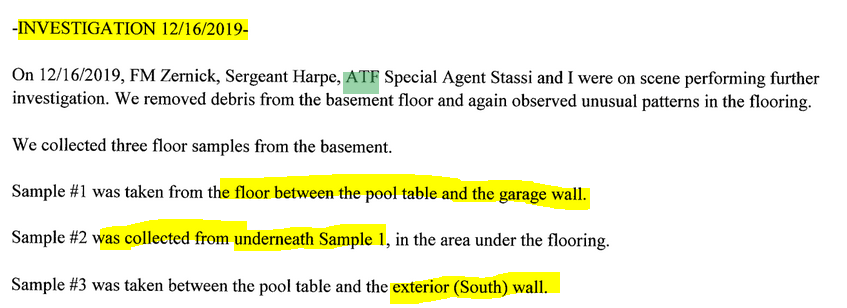
You can clearly see the locations of floor samples 1, 2, and 3, and not one of them was taken from the storage closet (Red X). It’s also important to note that the suspected second origin (Samples 1 and 2) showed no accelerants in any lab results.
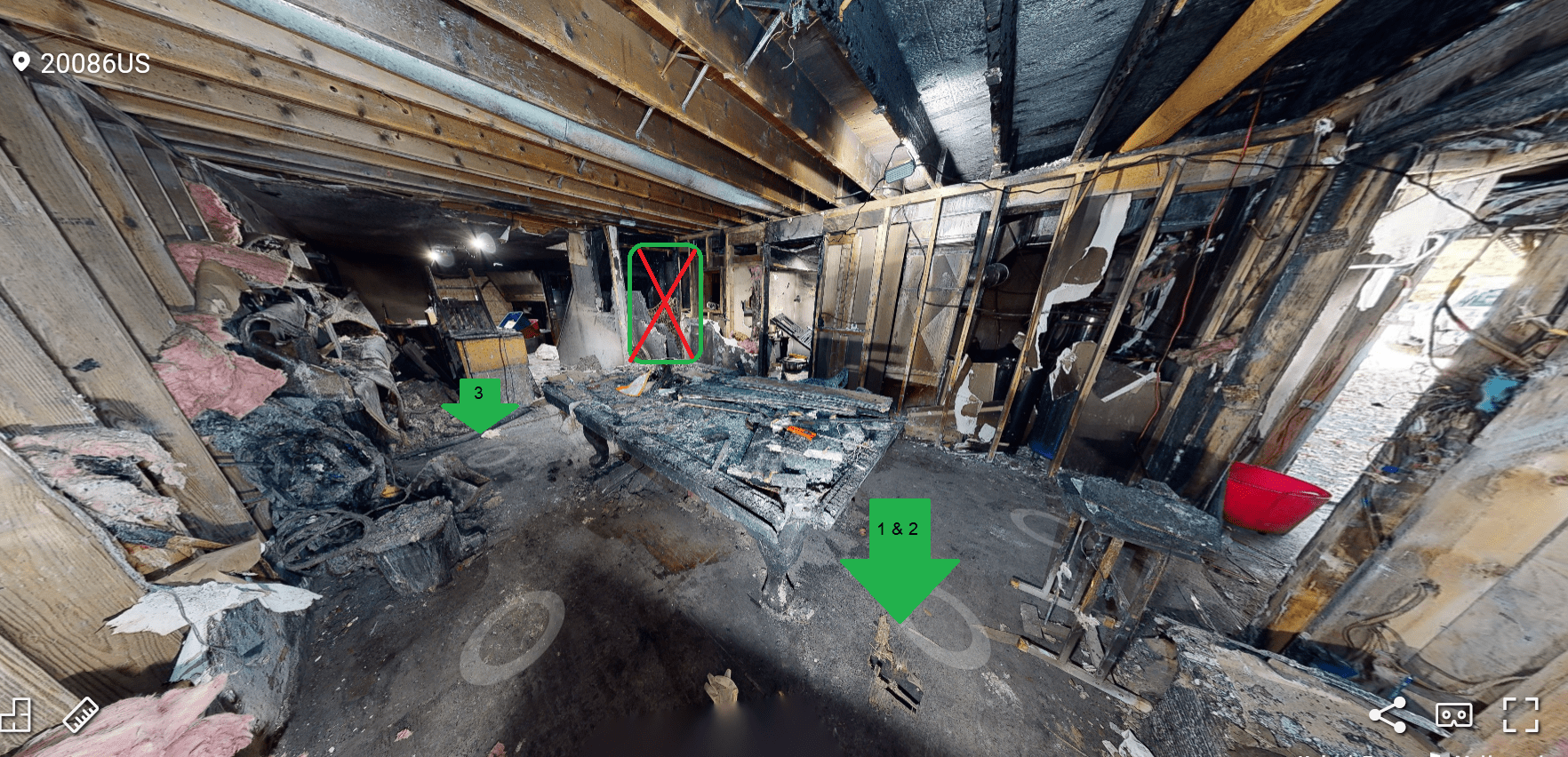
The above information was provided to us by an anonymous source from within Hamburg. The intention of this tip was to show that Hamburg allegedly did not test the floor within the suspected point of origin. This aligns with other aspects of the investigation into this house fire, suggesting a lack of training and proper protocol following NFPA 921 guidelines.
To get back to the original section of this report, we will now dive into the ATF’s role and the disturbing findings discovered by the homeowner.
ATF Report
We encourage everyone to read both ATF reports in their entirety; these can be found in our evidence room. On December 11th and December 16th 2019, the ATF was requested by Hamburg Public Safety Sergeant Harpe to assist Hamburg with an additional fire scene and evidence examination. ATF Special Agent/Certified Explosive Specialist/Bomb Technician (SA/CES/BT) John Franklin, along with Special Agent/Certified Fire Investigator (SA/CFI) Mike Stassi, traveled to the Hamburg Township Police Department to conduct an evidence examination.
While at Hamburg, they examined the evidence seized by Hamburg Public Safety. In Section One of their report, the ATF cites a halogen light, a plastic tray of oil, a power strip, and cloth. There’s an issue here: there is no plastic tray documented anywhere in any reports, pictures or logs. (If this claim holds true, it reflects an amateurish approach and raises serious concerns about the ATF’s examination of the evidence. It would suggest either that the ATF did not thoroughly analyze the evidence presented to them or that they were provided with something other than the actual tray from the scene. )

The ATF went on to document the light bulb and review scene photographs . Remember, in Part 1, we discussed how investigators lied under oath and claimed the bulb was a much higher wattage. They report here it was only 80 watts not the testified to 150 watts. The ATF proceeded to state that the placement of cloth materials and a pan of oil near the light fixture was intended to intentionally set a fire. (This action directly contradicts NFPA 921 guidelines, representing a significant departure from established investigative standards.)

One of the critical points is that the ATF based their conclusions on photographs they reviewed. They assumed, without detailed reasoning, that the seized items were positioned near the light fixture to intentionally start a fire. They did not test this theory or suspected items directly; instead, they relied solely on post-fire photographs. This approach may not align with NFPA 921 guidelines, which emphasize the importance of thorough testing and analysis before reaching such conclusions. (We will delve into why this may have occurred at the end.)
After reviewing the photographs, the ATF decided to visit the scene and conduct a “limited examination.” They discovered two localized areas of fire damage: one on the ceiling and one within the closet. It’s important to note that this visit occurred weeks after the fire, during which time excavation had already been performed, and the scene had been rummaged through by both members of Hamburg Public Safety and the public.
We also know that the ATF did not test their theory of the two areas of origin and how they were connected (see Part 1).

The ATF wanted to conduct more excavation beyond what everyone else had already done to find the areas of origin. They decided they would return on December 16th (nearly a month after the fire), leaving their investigation open.

During the ATF’s follow-up visit, their report covered many things:
- Suspected Points of Origin: They examined the two suspected areas where the fire might have started.
- House Foundation and Structure: An assessment of the building’s integrity and any structural issues was conducted.
- Utilities Status: It was noted that both gas and electrical services were connected at the time of the fire.
- Exterior Damage: The report detailed areas of the house’s exterior that were affected by the fire.
- Irregular Burn Pattern: An “irregular burn pattern” was observed on the floor, which was highlighted in their findings.
Interestingly, the report concluded by designating the fire as incendiary, pending additional witness statements and laboratory analysis. This designation is notable because, according to NFPA 921 guidelines, a fire should not be classified as incendiary until all other possible causes have been thoroughly ruled out. The report does not mention any specific theories about how the fire started or provide detailed scenarios explaining their conclusions.

After receiving the ATF report, the homeowner was in utter disbelief. Without any testing, scene recreation, witness statements, or laboratory analysis of floor samples, the ATF had based their conclusions on post-fire photographs—without knowing how the basement looked or was arranged before the fire. They mainly assumed that two points of origin meant the fire was incendiary.
The homeowner, who had taken NFPA 921 classes, knew there was something wrong with these reports. They were completely lacking in necessary detail and, in no way, shape, or form, would be considered valid by NFPA 921 standards. He wondered why professionals at the ATF would assume an incendiary fire based on what they themselves described as a limited investigation.
The homeowner attempted to obtain more information from the ATF through a Freedom of Information Act (FOIA) request but was sent the same reports that had already been provided, with no additional details. No sketches, lab analyses, work-ups, or supporting documentation were included, because they did not exist. This lack of further information raised additional red flags for the homeowner.
Concerned about the apparent deficiencies in the investigation, the homeowner decided to go directly to the source. He contacted Agent Rosemary Kane at the Information and Privacy Governance Division, Office of Public and Governmental Affairs, Bureau of Alcohol, Tobacco, Firearms, and Explosives in Washington, D.C
The homeowner was able to obtain the internal management log from the Detroit division of the ATF concerning the house fire. This document provided additional and deeply concerning insights into the investigation and the actions taken by both the ATF and Hamburg authorities in response to the incident.
Within this log file, the ATF verifies the limited investigation as discussed in their reports. Notably:
- 93 days after the fire, they recommended the denial of insurance coverage.
- 189 days after the fire, they requested the cause and origin report.
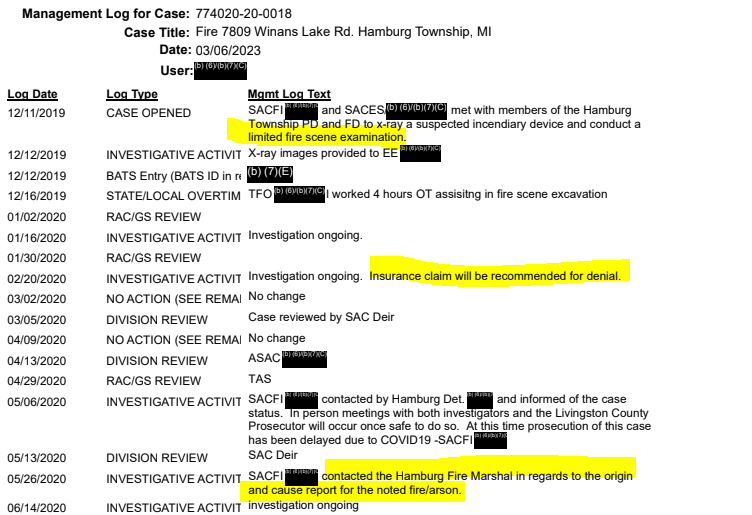
- 211 days after the fire, the Fire Marshal was still drafting the cause and origin report.
- 234 days after the fire, the cause and origin report remained unfinished and was still being drafted.
- 275 days after the fire, the homeowner was listed as a victim, and it was stated that there was no evidence of a federal arson violation. The also stated they will provide expert statements as it pertains to origin and cause of arson. (They never did an origin and cause investigation as you will see shortly)
- 291 days after the fire, ATF is still waiting on an origin report from Jordan Zernick
- 367 days after the fire, ATF is still waiting for Jordan Zernick to draft the origin report
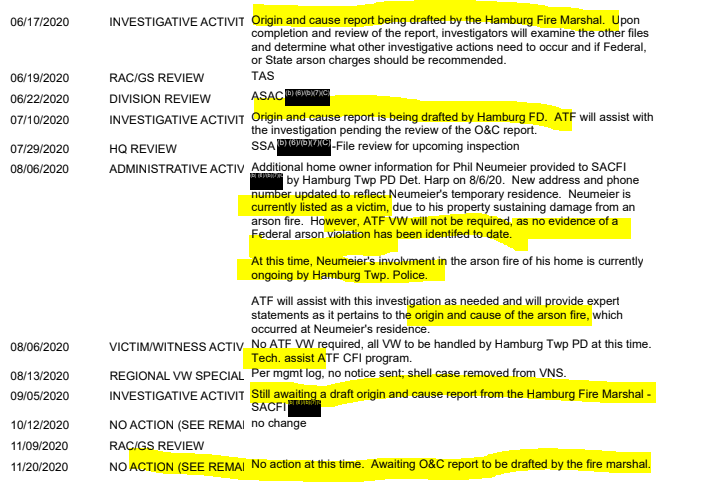
- 416 days after the fire: The Hamburg Police Department (PD) and the ATF communicate for the purpose of preparing a presentation to the Livingston County prosecutor.
- 472 days after the fire: Awaiting action from the assistant prosecuting attorney.
- 579 days after the fire: The ATF closes the case; the prosecutor decides not to pursue charges.
- 1,190 days after the fire: The case is reopened, and charges are filed.
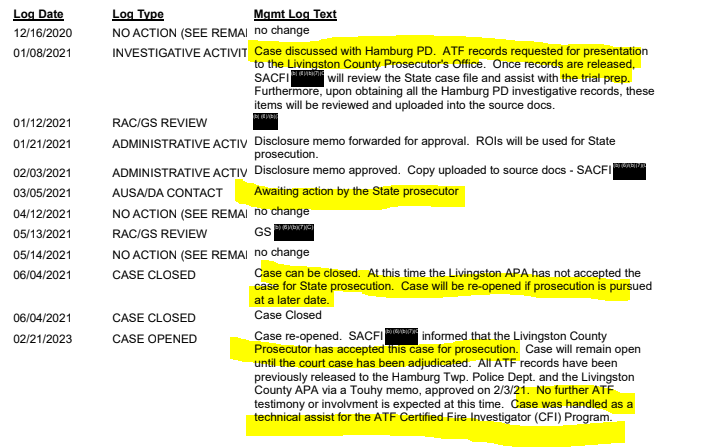
When reviewing the logs, several points stand out. Notably, the Fire Marshal completed his cause and origin report on dated June 9, 2020, which was included in the discovery file against the homeowner—this was 203 days after the fire occurred. Yet, the ATF logs indicate that 367 days after the fire, they were still waiting for the origin report to be drafted.

From Part 2, we know that the Fire Marshal was consistently modifying his cause and origin report, allegedly removing key parts to limit potential legal liability. This discrepancy between the report submission date and the ATF’s records raises questions about the communication and coordination between agencies during the investigation.
The homeowner conducted a metadata analysis on the ATF report to determine when it was created. The information showed that the ATF report was created 34 days before the fire marshal’s report was even completed.
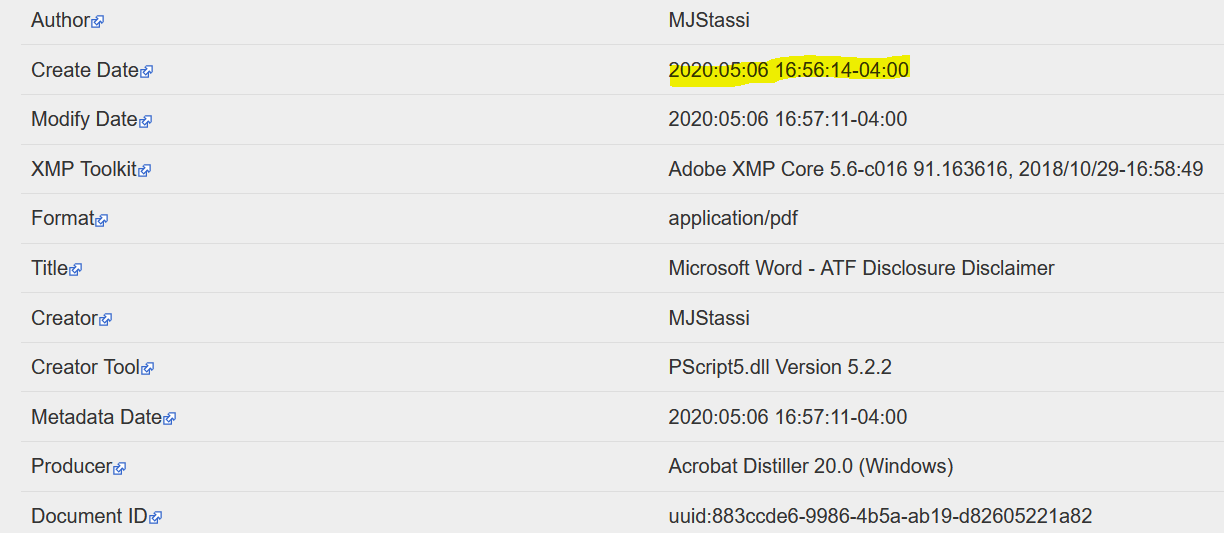
Further communication with Agent Rosemary Kane confirms that the ATF was on-site in an advisory capacity and did not conduct an independent cause and origin report, leaving that responsibility to Fire Marshal Jordan Zernick. Yet, the ATF was more than willing to provide statements in regards to origin and cause according to their log.

Even as of 2023, there is still no confirmation that the Fire Marshal ever submitted his cause and origin report to the ATF. This situation leads to the opinion that the ATF may have lacked the ability to conduct a full investigation, having reported the fire as incendiary before receiving any origin report. Since they did not conduct their own origin and cause investigation, this could explain why the management log indicates that no charges were initially going to be placed against the homeowner, and the case was closed by the ATF. That was until February 21, 2023, when the case against the homeowner was reopened.

According to standard protocols, the ATF should not have designated the fire as incendiary without performing their own thorough investigation. After the homeowner investigated this matter, the ATF logged that indeed their “investigation” was merely a technical assist.
Further Evidence of a Concerted Effort Between the Insurance Company and Hamburg Public Safety
After the fire, leading up to 2023, Hamburg Public Safety continued to pursue charges against the homeowner. It is alleged that they worked with the insurance company, providing evidence to them while withholding it from the homeowner. While Hamburg claimed that their investigation was separate from that of the insurance company, evidence presented in Part 1 suggests this was not the case.
The homeowner was able to obtain digital communications between insurance company representatives and Hamburg Public Safety, which he believes correlate to a direct effort to negatively and intentionally affect the outcome of his case.
This raises questions about the independence of the investigations and suggests a potential concerted effort between Hamburg Public Safety and the insurance company.
As part of Operation 232 conducted by the homeowner, he requested information using the Freedom of Information Act (FOIA), either directly or through one of his attorneys. On November 13, 2020, 360 days after the fire, the homeowner submitted a request for evidence.
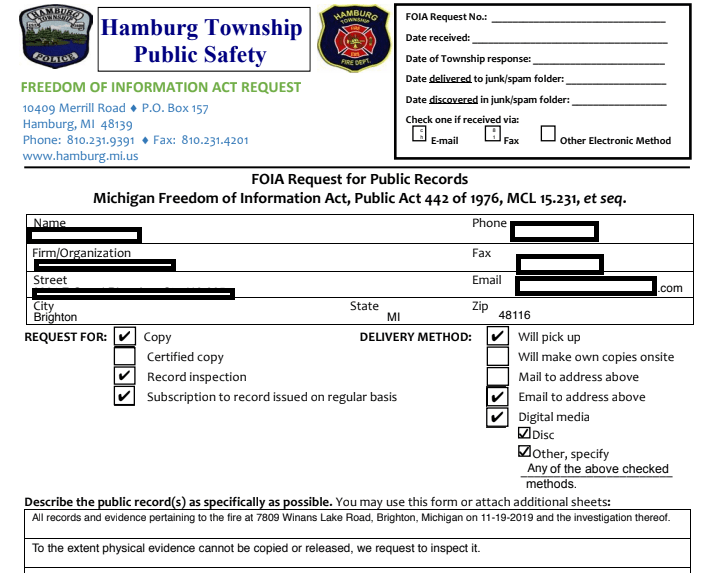
This request was denied, but it was the reasoning and explanation provided by Hamburg Public Safety that was particularly shocking to the homeowner. It was denied because the information was part of an ongoing investigation and releasing it would interfere with that investigation.
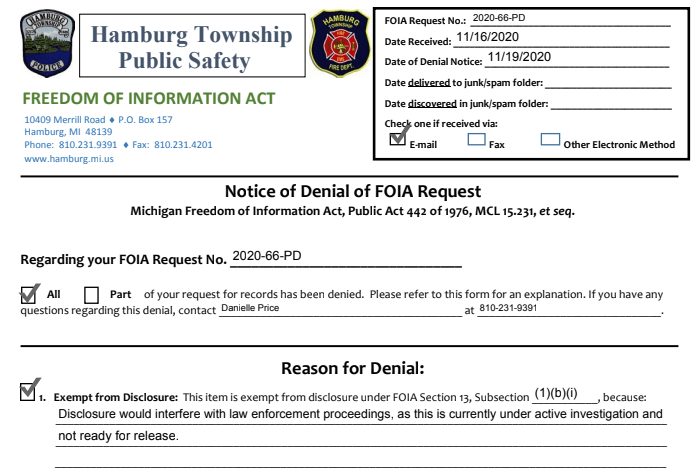
In the FOIA response letter, it went into more depth regarding additional reasons for the denial. It stated that the information was not ready to be released and provided further explanations as to why the request could not be fulfilled at that time.
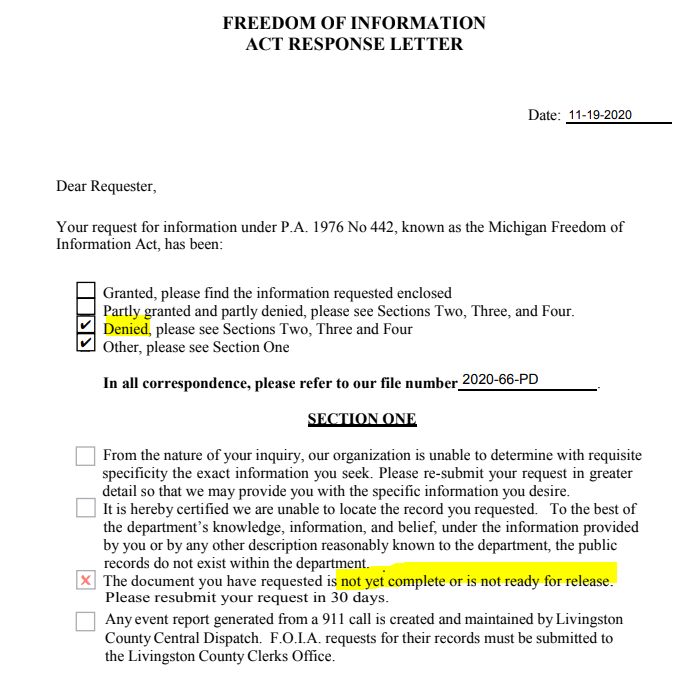
In the final section of Hamburg’s FOIA response, it reinforced that the release of information would interfere with law enforcement proceedings.
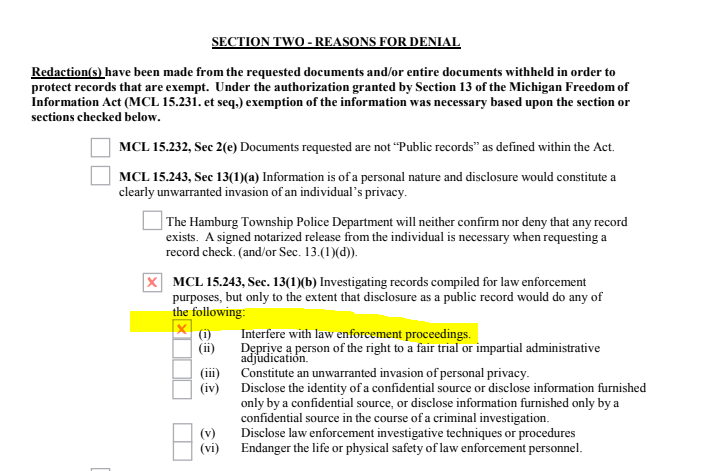
Even 539 days after the fire, Hamburg was still delaying the FOIA process, as confirmed by a follow-up email to Hamburg Public Safety.

The homeowner found the initial denial and continual denials of his Freedom of Information Act (FOIA) requests to be absurd. According to him, it became clear that Hamburg Public Safety was deliberately attempting to delay the release of information in an effort to conceal crucial details. Initially, the homeowner was unable to substantiate these suspicions and had to table that aspect of Operation 232.
It wasn’t until November 23rd, 2022, nearly 1,100 days after the fire, that the homeowner was able to prove that Hamburg Public Safety had intentionally delayed the release of information to him. Furthermore, he uncovered evidence of behind-the-scenes communication between his insurance company and Hamburg Public Safety, suggesting a possible conspiracy against him. Hamburg’s email server was accessed legally by a member of Hamburg Public Safety, and the resulting emails were provided to the homeowner. These emails have been verified, corroborating the homeowner’s claims of suspected collusion.
The following revelations underscores the prolonged and obstructive efforts by Hamburg Public Safety to withhold information, thereby impeding a fair and transparent investigation. The verified communications between the insurance company representatives and Hamburg Public Safety members indicate a coordinated effort to negatively influence the case’s outcome. These findings highlight significant ethical and procedural breaches within the investigative process, warranting further scrutiny and accountability.
Internal Hamburg Public Safety Communication
The homeowner discovered that while his request for evidence was denied on November 16, 2020, Sergeant Gary Harpe of Hamburg Public Safety granted Tony Wood, a member of the public working for the insurance agency, a request for evidence—specifically, copies of the homeowner’s hard drive on March 12, 2020.
The homeowner’s hard drive was the DVR video surveillance from his security system. Hamburg Public Safety accepted the request to access this footage and subsequently shipped it to representatives of the insurance company. The intention behind this action was to have the insurance company representatives question the homeowner about the footage before the homeowner had an opportunity to review any of the data himself.
This discrepancy which was clearly to help the insurance company and at the same time hinder the homeowner raises serious concerns about the impartiality and fairness of the evidence request process. The homeowner was denied access to critical information that could aid in his investigation, while a representative from the insurance agency was granted access to his personal data without similar scrutiny. Nor was Tony Wood denied due to “an ongoing investigation” This unequal treatment suggests potential biases and undermines the integrity of the investigative procedures followed by Hamburg Public Safety.
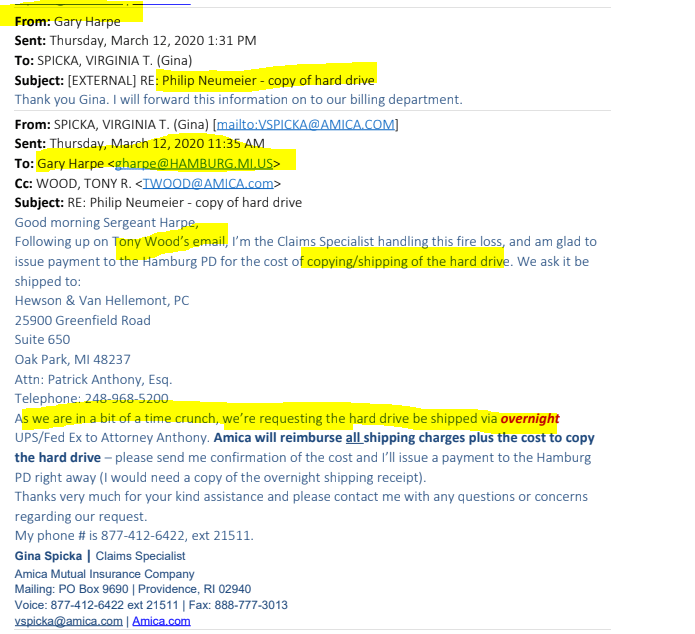
To further support the claim of biased denial, Hamburg Public Safety not only sent the homeowner’s hard drive but also emailed the reports to a member of the public working for the insurance company. According to the ATF the fire marshal was still drafting the report at this time. Should that be true Hamburg would be responsible for sending incomplete reports and evidence to the homeowners insurance company while an investigation by Hamburg was still ongoing. This was all approved by Sergeant Gary Harpe in an effort to facilitate an examination under oath between the homeowner and the insurance company. The purpose of this meeting was to have the homeowner questioned again but this time by the insurance company attorneys, thereby giving the insurance company an undue advantage in the investigation. How is it a the fire marshal’s report was sent in March of 2020 to the insurance company from Hamburg Public Safety when it was not complete until June 2020?
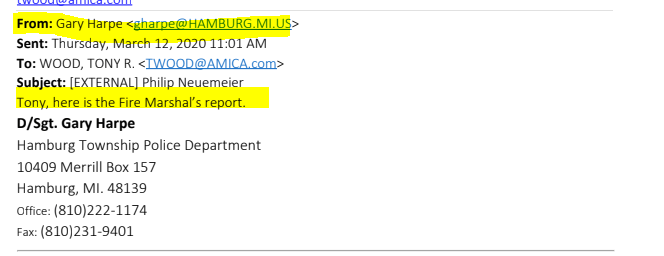
This discrepancy raises significant questions about the integrity of the process and the accuracy of the information provided by Hamburg Public Safety. If the fire marshal’s report was sent to the insurance company in March 2020, despite not being completed until June 2020, it suggests either:
An Early Draft Was Shared: If an incomplete or draft version of the report was sent, it would indicate that the insurance company may have relied on information that was not finalized or verified, which could skew their assessment and actions.
Intentional Misrepresentation: If the report was falsely presented as complete, it could point to an attempt to influence the insurance company prematurely or manipulate the investigation’s narrative..
This situation underscores the importance of a clear chain of custody for documentation and evidence, as well as the ethical responsibility to ensure all shared materials are accurate and finalized. It also highlights the need for a thorough examination of the communication and actions between Hamburg Public Safety and the insurance company during this investigation
If you are still wondering how badly Hamburg Public Safety did not want the homeowner to have a copy of his own hard drive or evidence, it becomes quite clear when examining their actions. Hamburg Public Safety sold a copy of the homeowner’s hard drive to members of the public working against him for $200, while simultaneously attempting to charge the homeowner $38,952 for a copy. This significant discrepancy highlights an apparent attempt to restrict the homeowner’s access to his own evidence while providing copies to others at a nominal fee, thereby undermining the homeowner’s ability to review and utilize his own data effectively.
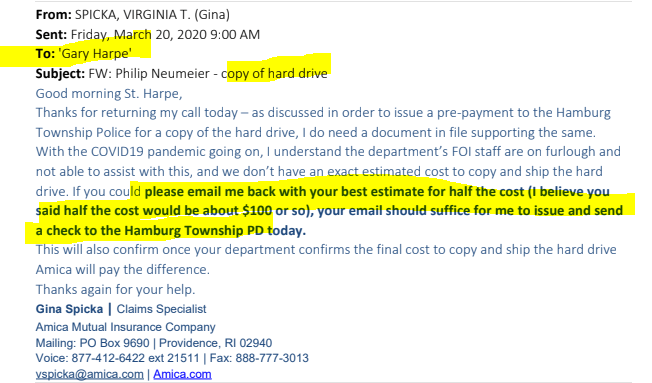
It was not until September 28th, 2022, 917 days after Tony Wood’s request was approved, that the homeowner was finally granted permission to obtain a copy of his hard drive. While other members of the public were able to acquire a copy for $200, the homeowner was presented with an estimated $38,952 for the exact same copy. Moreover, they claimed that redactions were necessary and that only three employees were available to devote a few hours each day to the redactions. Even with three people working 9 hours each, it would take over two more months to complete the redactions.

So, how did the insurance company obtain a copy within days of requesting it?
We asked the homeowner, and his response was direct:
“That’s easy. I suspect Hamburg were colluding with the insurance company. I’d assume they sent them an unredacted copy. They did not want me to have the surveillance video as they knew it would help me if the insurance company had questions, which they did. They (Amica and Hamburg) used the video to draft questions. The insurance company was partially involved in Sergeant Harpe’s bidding, and Sergeant Harpe prevented me from obtaining the same information. Even though I should have been legally entitled to it. They even sent members of the public other things such as Jordan’s reports while denying me and claiming they couldn’t send out anything because it was an active investigation. Even if it was legal it’s wrong. Speaking on legal and illegal, Hamburg even sent drafts reports to the insurance company before any investigation was remotely complete, these reports show a different narrative. It wasn’t even to insurance investigators they sent them to office managers/staff. They thought I would never find out about this. I’m truly not shocked at all by their behavior at this point.”
While the practice of police working with insurance companies is not inherently illegal, there are strict rules and laws that must be followed to ensure ethical and unbiased investigations. In this case, several concerning practices have been identified that may violate these protocols and the homeowner’s constitutional rights.
Evidence from an ongoing investigation should be handled with the utmost care and integrity. However, it has come to light that Hamburg Public Safety may have engaged in selective disclosure by providing informal access to critical evidence to the insurance company. For example:
Draft Copies of Incomplete Reports: Hamburg Public Safety allegedly shared draft copies of incomplete investigation reports with non-investigators from the insurance company. This practice undermines the integrity of the investigation and prevents the homeowner from accessing complete and accurate information.
Informal Sharing of Evidence: The homeowner’s hard drive, containing vital video footage from the day of the fire, was sold to insurance company representatives for a nominal fee of $100, while the homeowner was quoted $38,952 for the same copy. This discrepancy suggests an attempt to restrict the homeowner’s access to his own evidence while providing the insurance company with privileged information.
Legal Implications and Constitutional Rights
The unauthorized and selective sharing of evidence raises significant legal concerns, particularly regarding the homeowner’s constitutional rights:
Due Process: The homeowner is entitled to a fair and impartial investigation. By selectively disclosing evidence to the insurance company, Hamburg Public Safety may have compromised his right to due process, as the insurance company gained access to information that could be used to question and potentially discredit him without his opportunity to review or respond adequately.
Privacy Rights: Any unauthorized access and distribution of the homeowner’s personal data, such as video footage from his hard drive, infringe upon his privacy rights. This violation not only undermines his ability to defend himself but also breaches the trust and confidentiality expected in such investigations.
This practice not only demonstrates a lack of transparency but also raises serious ethical and legal concerns regarding the handling of evidence and the fairness of the investigation process. Such actions suggest a deliberate effort to control the narrative and limit the homeowner’s capacity to defend himself adequately.
We have determined that Hamburg Public Safety was sending incomplete data and reports to the homeowner’s insurance company, as evidenced by the timestamps on their correspondence. Sergeant Harpe sent the Fire Marshal’s report to the insurance company on March 12th, 2020.
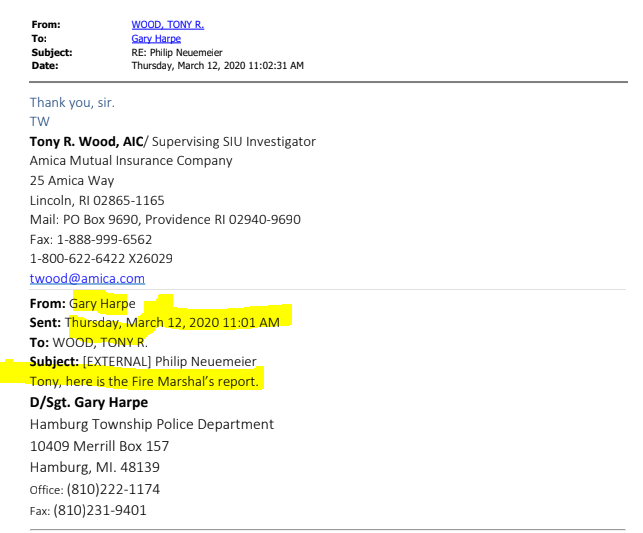
This report was incomplete and based on information provided by the insurance company, which was subsequently altered (see Part 2 draft report). Additionally, the report remained unfinished this also supported by the ATF log indicating that the drafting process spanned years. Even with ignoring the ATF log, Fire Marshal Jordan Zernick’s report was not completed until June 9, 2020, by his own admission. The report was finalized 89 days after Sergeant Harpe sent the report via email to the insurance company.
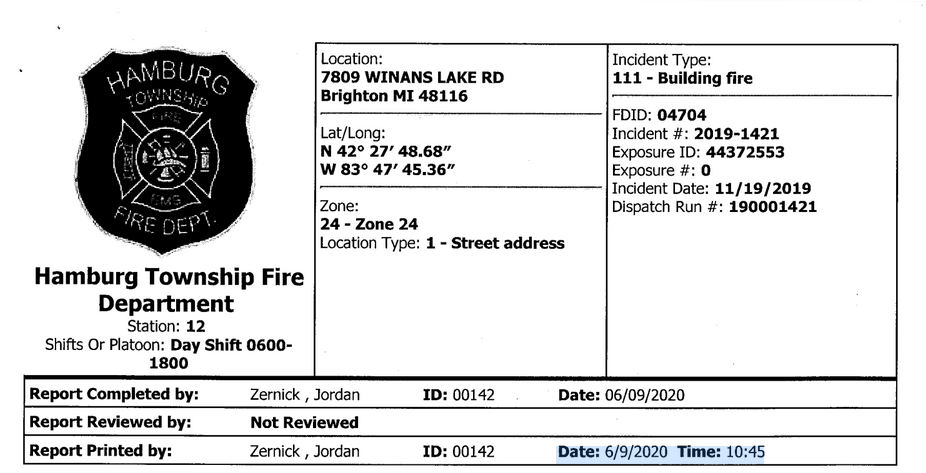
While numerous emails between the insurance company and Hamburg are available in our evidence room, we will present additional correspondence that demonstrates a bias against the homeowner.
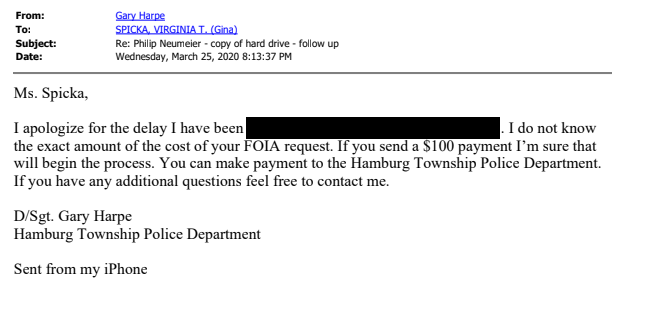
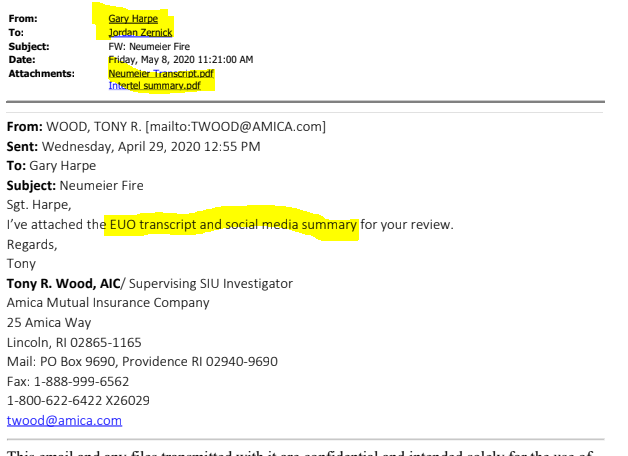
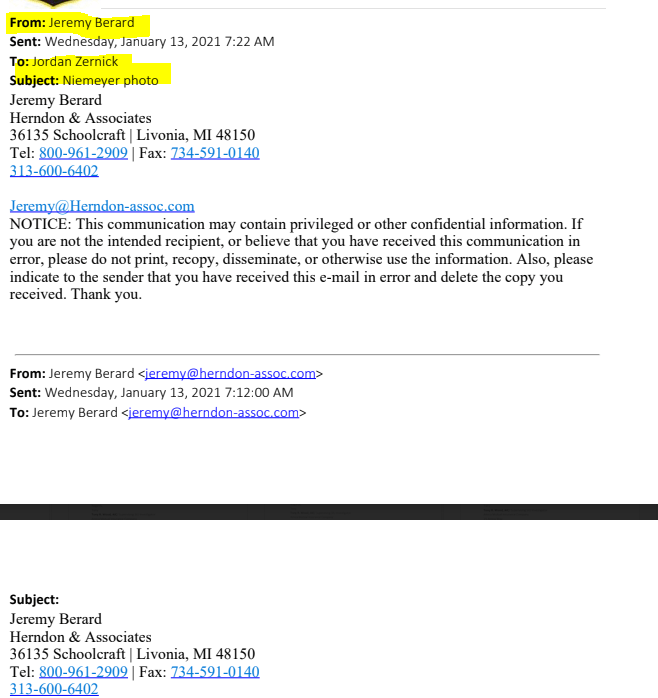
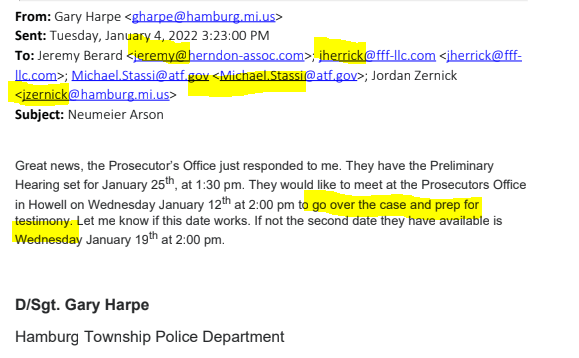
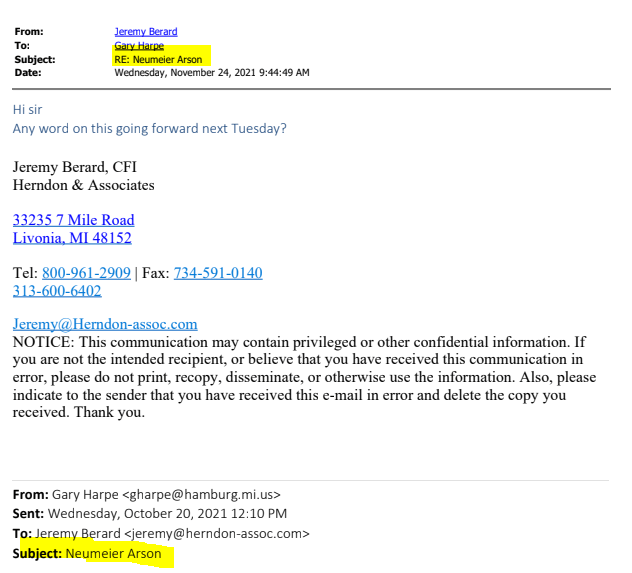
The aforementioned emails are significant not only because of their potentially biased subject lines but also due to their recipients. In the second email, Sergeant Harpe is organizing a meeting for group testimony preparation, which includes both government and non-government witnesses. The significance of such a group meeting lies in its inherent bias, as it brings together government personnel and members of the public, including Jeremy Berard (an insurance-hired investigator) and Jay Herrick (hired by Jeremy Berard or Amica insurance).
Most notably, ATF Agent Michael Stassi is included in this email. One of the most direct indications of potential biased acts is that the ATF agents who are witnesses against the homeowner are involved in preparing testimony. This suggests a coordinated effort to prepare witnesses, potentially undermining the homeowner’s position.
This potential claim is supported not only by the emails sent by Sergeant Harpe but also by the ATF log dated January 8, 2021. SACFI refers to Mike Stassi, Special Agent Certified Fire Investigator, who is leading the investigation. He logged that he is going to assist with the trial prep. Any involvement by both government officials and insurance company representatives in testimony preparation raises serious concerns about the impartiality and integrity of the investigation process.

Other Tips Submitted - Follow Up
Over the past few months, we have received multiple tips from various members of the Livingston community, prompting further investigation into the circumstances surrounding the house fire. Many of the tips have been covered in Parts 1 and 2. One of the most recent and verified tips challenges the Fire Marshal’s testimony regarding the condition of the fire’s origin scene.
While the Fire Marshal asserted that the origin of the fire was undisturbed and that he waited for the insurance investigator to arrive before proceeding with his investigation, records from a member of the Hamburg Police Department reveal a different scenario. Specifically, it has been confirmed that the homeowner’s storage closet, suspected to be the fire’s point of origin, was not undisturbed. In fact, numerous items were moved prior to the initiation of the origin and cause investigation during the overhaul process.

This evidence directly contradicts any statements asserting that the area remained undisturbed, thereby rendering such testimonies false. The alteration and movement of items in the storage closet (under the stair case) undermine the integrity of the initial investigation and suggest potential mishandling of the fire scene. This information was sourced directly from Officer Flavin in writing. Not only does this disprove testimony it shows the judge in this case was misled by Hamburg Authorities when he explained the origin was undisturbed. The fire marshal would also mislead the insurance agent into believing he was investigating an untouched scene and led him to believe the items moved came from a different location.


During the July motion hearing before Judge McGivney, Officer Spencer Flavin and Fire Marshal Jordan Zernick provided testimony to justify their actions on the day of the fire. They both asserted that they did not suspect any criminal activity had occurred during that time. However, a subsequent tip has emerged that contradicts their statements. This conflicting information was directly provided by Sergeant Gary Harpe of Hamburg Public Safety, indicating that there were indeed suspicions of criminal activity that were not disclosed during the hearing.

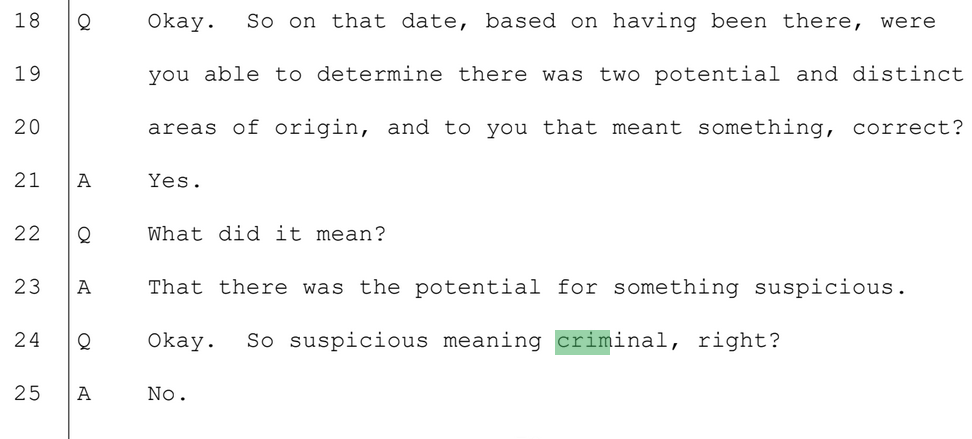
Why would Hamburg testify that they did not suspect a crime occurred on the night of the fire? A potential justification provided was that they conducted a search of the house without a warrant, a procedure that typically requires exigent circumstances to be legally permissible. Recall from Part 2 how Hamburg misled the judge into believing that the house remained on fire for several days for the same reason.
As a result, what was the outcome of the testimonies from Officer Spencer Flavin and Fire Marshal Jordan Zernick? The judge accepted their accounts as credible.
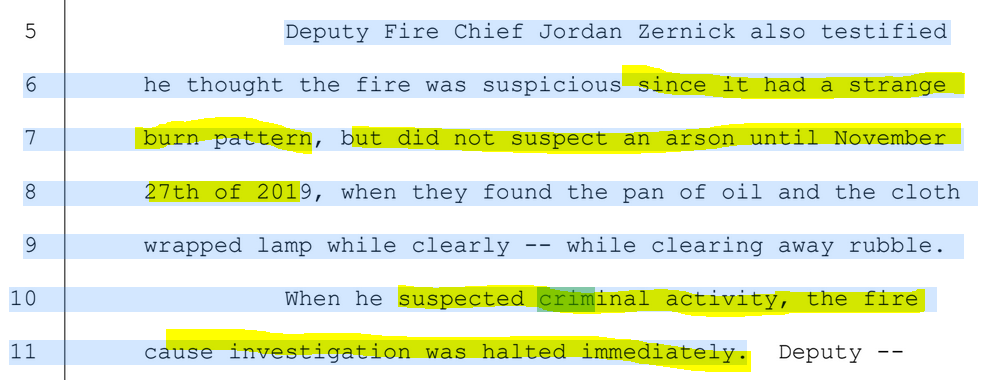

The tip included information from a statement made by Sergeant Gary Harpe. On the date of the fire, November 19th, Sergeant Harpe, whose responsibility lies in criminal investigations, was contacted by Fire Marshal Jordan Zernick regarding the origin points of the fire. According to Zernick, the origin points were indicative of an incendiary fire, suggesting potential criminal activity.
Furthermore, as detailed in Part 1, we utilized this information in our investigative actions, uncovering that Fire Marshal Zernick had initially claimed to possess a signed consent form for certain investigative procedures. However, later statements from the Fire Marshal, made under oath, revealed that this consent form did not exist the day of the fire.

As noted in Part 1, Sergeant Gary Harpe is not an expert in fire investigations; his primary involvement lies in criminal investigations, specializing in evidence collection. This distinction raises significant concerns when we discovered that there was no chain of custody for the evidence Hamburg Public Safety took from the homeowner. The absence of a proper chain of custody compromises the integrity and admissibility of the evidence, potentially allowing for claims of tampering or mishandling.
However, as our investigation progressed, we uncovered something very peculiar.
On November 27th, 2019, eight days after the fire, Fire Marshal Jordan Zernick reported finding a lamp that was “indicative of an incendiary device.” Following this discovery, Sergeant Gary Harpe was contacted, and the lamp was subsequently taken into evidence as part of the ongoing investigation.
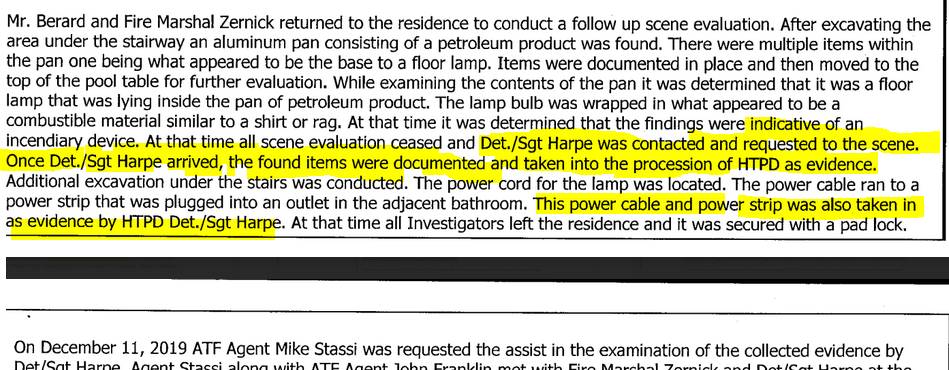
On November 27th, Sergeant Harpe corroborated the Fire Marshal’s position in his report by stating arriving at the homeowner’s residence to collect the evidence.

In Part 1, we discuss the absence of a proper chain of custody for the evidence taken from the homeowner’s residence. Additionally, any documentation that exists is of extremely limited value. However, even with these limitations, significant errors are still evident.

For instance, the police report vaguely documents that Sergeant Gary Harpe claims the incendiary device was taken on the day of the fire, November 19th, 2019. In contrast, both his report and Fire Marshal Jordan Zernick assert that the device was collected on November 27th, 2019. Is this a simple error? Not quite, as the discrepancy delves much deeper.
On January 30th, 2020, Jay Herrick, a member of the public hired by Amica Insurance, was granted permission to handle evidence seized by Hamburg Public Safety, specifically the suspected incendiary device. Seargent Harpe permitted this even though there was an active investigation still going. This action raises significant concerns regarding the integrity and security of the evidence handling process.
This meeting would include detailed information regarding the status of the seized lamp.

Below are the photos taken at the police department by the third-party insurance investigators.
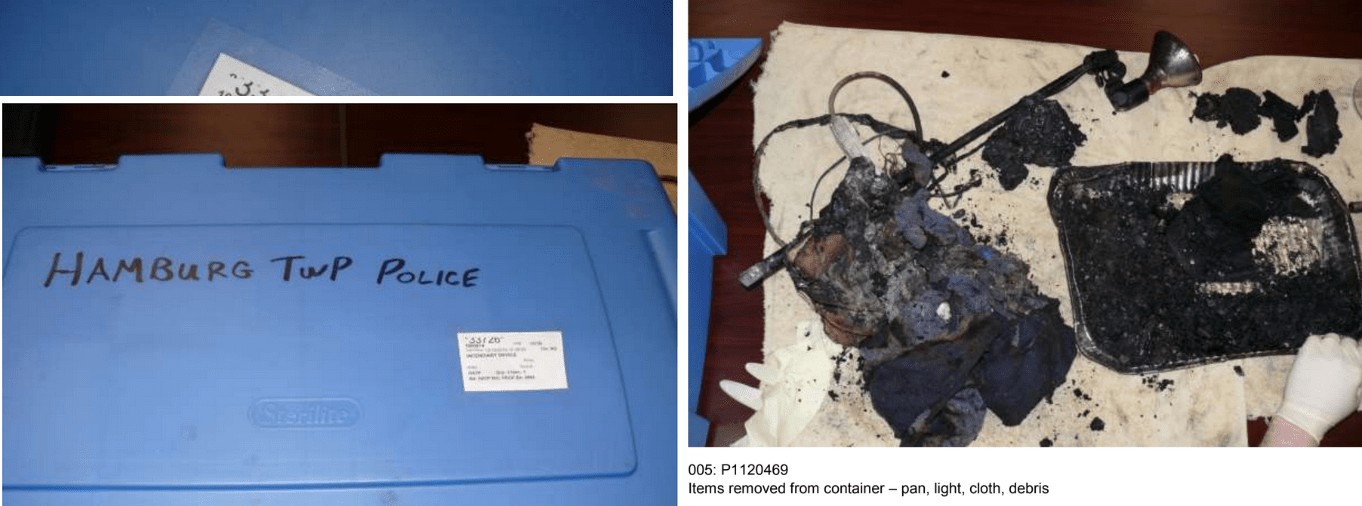
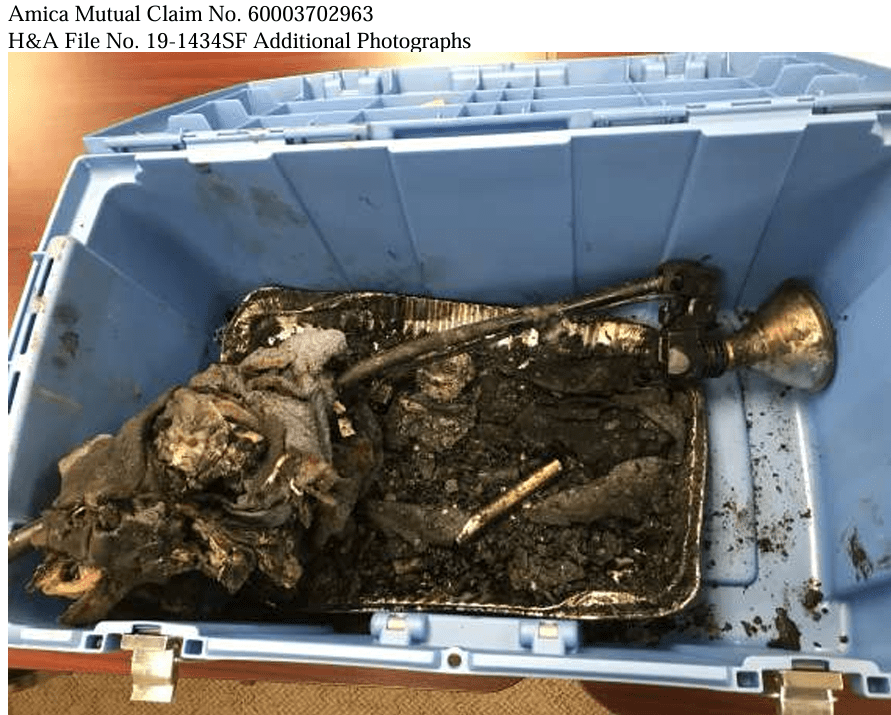
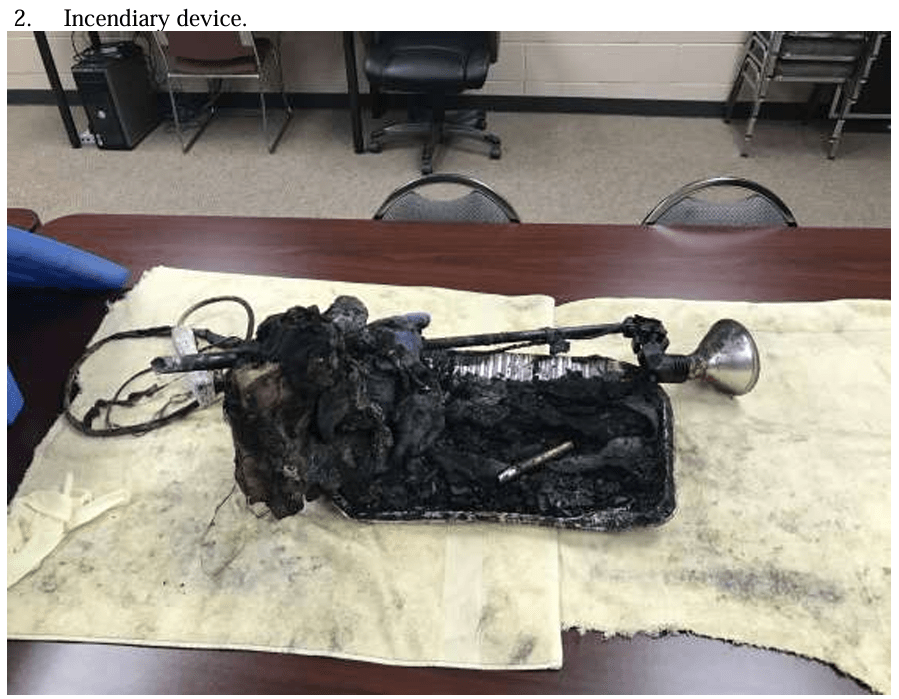
Jay Herrick captured a photograph of the evidence tag, which is significant because, upon further examination, the label indicates that the evidence was submitted on December 18, 2019. This date is problematic, as it contradicts earlier findings that Sergeant Gary Harpe had already handled and submitted the evidence on November 27, 2019. Given this timeline, the evidence could not have been contained or submitted on December 18, 2019, as previously demonstrated by Sergeant Harpe’s actions. This discrepancy raises serious concerns about the accuracy and integrity of the evidence handling process, suggesting potential manipulation or misrepresentation of the evidence submission timeline. Why did he do this? We are not sure but the manipulated label date would coincide with the execution of Sergeant Harpe’s search warrant, it presents a significant discrepancy in the investigation timeline and evidence handling.
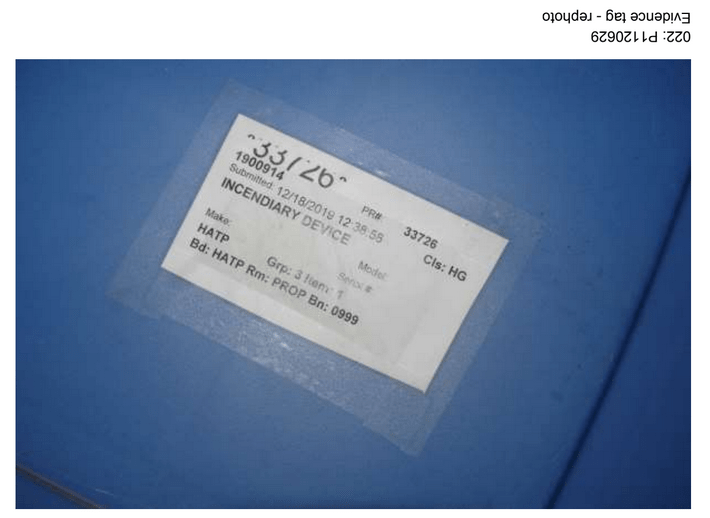
Upon uncovering this information, the homeowner remarked that he was not surprised, considering other findings and the absence of a proper chain of custody. He did not rule out the possibility that the evidence might have been deliberately manipulated to appear as though it was collected at one time and then submitted nearly three weeks later.
During the review of the evidence photographs, the homeowner identified a particularly concerning detail. In the images captured when Jay Herrick, a third-party non-governmental investigator, removed items from the bin, the lamp was depicted with cloth wrapped around it, alongside a power strip. The homeowner noted that the power strip had been taken at a different time, raising questions about why both items were placed together in a single bin. Additionally, the extensive amount of cloth surrounding the lamp was deemed unusual.
By late January 2019, Sergeant Gary Harpe, Jeremy Berard, ATF personnel, and Jay Herrick had all handled this evidence, suggesting that it may have been tampered with each time it was removed. Despite this, the significant quantity of cloth depicted as being wrapped around the lamp remained inexplicable. This inconsistency led the homeowner to make one of his most substantial discoveries to date.
The homeowner asserted on-site that he is certain Hamburg Public Safety staged his house once again. He claims to have proof that no cloth was found attached to the lamp. When questioned, as reported in Part 1, about how the lamp might have fallen into the furniture pad he said that’s still on the table but he promptly responded that he needed a day or two to compile his evidence. He admitted that he could substantiate claim but was initially unsure how to articulate it.
A few days later, the homeowner presented a video or photos that scrutinizes Hamburg Public Safety’s actions, supporting the assertion that they assisted in staging the lamp. The video or photo demonstrates that the cloth was never actually attached to the lamp, it was placed there after the fire by Hamburg. This further reinforcing the homeowner’s allegations of evidence manipulation. We were able to verify the same images used in the video with the images provided by FOIA and metadata. It is factually accurate and is posted with permission below.
We will revisit this section shortly, jumping ahead in this article to address other key points before presenting the evidence related to the fire marshal’s involvement with the lamp and cloth.
Chief Nick Miller
There have been previous discussions and interactions suggesting that the former Chief, Nick Miller, may have been involved in the investigation of the fire at the homeowner’s residence. Multiple eyewitnesses have placed Chief Miller at the scene both on the night of the fire and the following day. While eyewitness testimonies are valuable, the homeowner required additional information before conclusively identifying Chief Miller’s presence at the scene the morning after the fire.
Chief Nick Miller’s narrative report exclusively attributes all investigative responsibilities to Fire Marshal Jordan Zernick. In his succinct one-page document, Chief Miller does not acknowledge his own involvement or role in the fire investigation. This omission raises concerns about the completeness and transparency of the official investigation records.
For a comprehensive understanding of Chief Miller’s perspective and involvement, his full narrative report is available in the evidence room under the “Fire Report” section. This detailed report provides additional context and insights that are not captured in the brief official narrative, highlighting potential gaps in the documented investigation process.

An internal email reveals that Fire Marshal Jordan kept Chief Nick Miller updated on the case status. While keeping the chief informed isn’t unusual, what stands out is that only a single email was sent, and it merely copied Chief Miller on the update. This limited communication raises questions, given Miller’s presence at the scene and his role in overseeing the department.
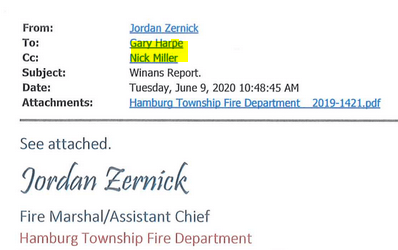
Sergeant Harpe’s narrative states that he met with the fire department but notably omits any specific names, including those of key individuals present at the scene.

Chief Nick Miller was one of the first responders on the scene and can also be seen on Officer Flavin’s body camera footage from the night of November 19, 2019. This early presence highlights his initial involvement, despite his absence from official reports detailing investigative roles and responsibilities. This may not be strange and just a lack of paperwork but the following day is where documentation should have been stringent.
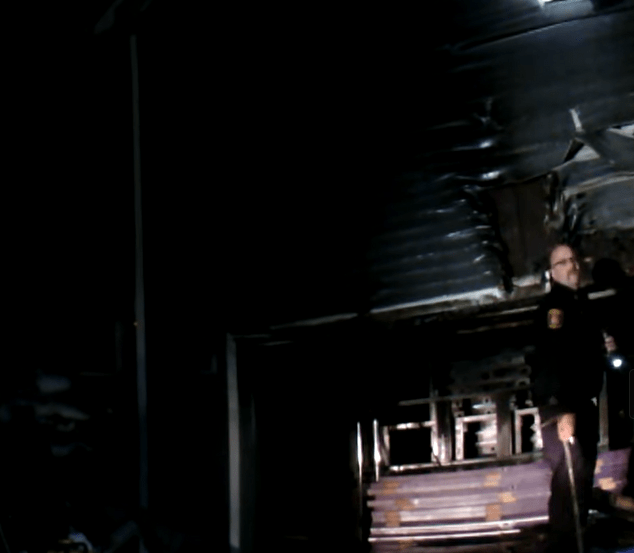
The most puzzling aspect of this case is the complete omission of Chief Nick Miller’s involvement from all official reports concerning the fire investigation. Despite his documented presence on the night of the fire, participation in trial preparation, attendance at the preliminary hearing, and eyewitness accounts placing him at the house during the week of the fire, there is no mention of his role in any investigative records. It’s as though Officer Flavin, Fire Marshal Zernick, and Sergeant Harpe all experienced collective amnesia, failing to acknowledge his presence or actions in their accounts.
At this point there is not any wrong doing being alleged in regards of the Nick Miller but other narratives began to unravel when the homeowner, through a source within Hamburg Public Safety, received photographic evidence. The individual in the photograph below was taken on November 20th, 2019—the day after the fire—was initially thought to be Chief Nick Miller. However, in the absence of cooperation from Hamburg Public Safety, we could not verify this identification. A source has since suggested that the person in the photograph is more likely Fire Marshal Jordan Zernick’s associate and friend, Captain Michael Steinaway. While absolute verification is still pending, the homeowner believes there is a strong likelihood it is Captain Steinaway, another individual conspicuously absent from official reports. This person has been ruled out as Sergeant Harpe, Officer Flavin or Fire Marshal Jordan Zernick.
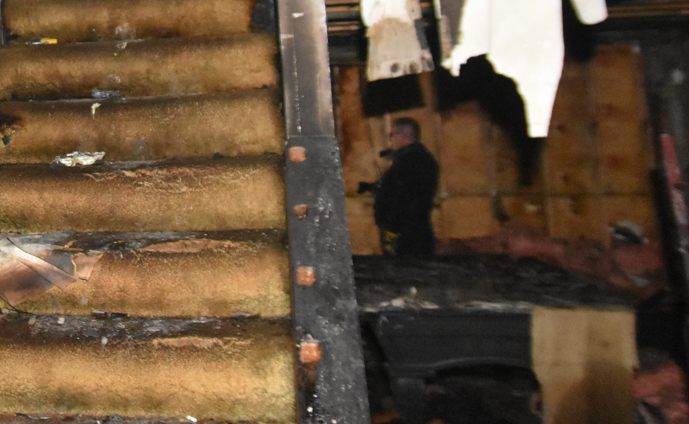
Additional photos or videos of Chief Nick Miller’s involvement may exist but cannot be released at this time per the homeowner’s request.
Potential evidence staging and procedural irregularities
In Part 1, we outlined an alleged staging event involving a fire escape ladder and Hamburg Public Safety. In this section, we delve deeper into another incident of staging that directly implicates Fire Marshal Jordan Zernick in actions that raise significant questions about the integrity of the investigation. This deeper examination highlights not only procedural inconsistencies but also potential intent behind the manipulation of evidence at the scene.
Seven days after the initial investigation entry on November 27th 2019, Fire Marshal Jordan Zernick, accompanied by an insurance investigator, were in the home around 12:38 PM to sift through the fire debris, excavate and investigate supposedly independently of each other. During this process, they located the tray and lamp, after which Zernick testified that he stopped investigating and contacted Sergeant Harpe to collect the evidence and seek a search warrant before continuing. However, Zernick’s own photos reveal that he remained in the area until at least 2:00 PM, well after locating the items in question. This deviation from procedure highlights a missed opportunity to follow proper protocols, such as securing a warrant and involving specialized investigators like the Michigan State Police fire investigation team. This inconsistency further raises questions about the overall investigative integrity maintained by the Fire Marshal.
The first photo timestamp on November 27th, 2019, places Fire Marshal Jordan Zernick at the scene of the house at 12:37 PM. We cannot verify the exact timing of his arrival before this, as 12:27 PM marks the timestamp of the first photo he took.
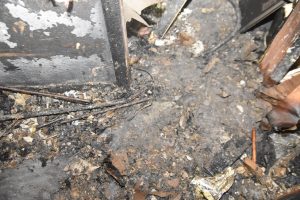
At 12:51 PM, the Fire Marshal and the insurance investigator (according to testimony) located the tray and lamp and subsequently moved them onto the pool table. At this point, according to reports, the Fire Marshal contacted Sergeant Harpe to seize the evidence.
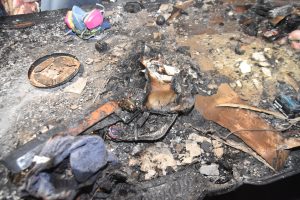
At this point, Fire Marshal Jordan Zernick should have halted the investigation to secure a warrant, especially as the insurance agent reportedly indicated that the lamp and tray assembly were incendiary devices. Despite testimony claiming that the investigation was paused, the photo timestamps reveal that both the Fire Marshal and possibly the insurance investigator continued to excavate the area around the homeowner’s closet. They remained onsite and actively investigating until approximately 2:00 PM, as evidenced by the last photo taken that day.
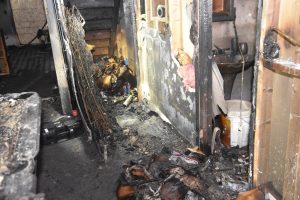
It is important to note that these photographs were never provided to the prosecutor; the homeowner had to obtain them through a Freedom of Information Act (FOIA) request. While analyzing the images to demonstrate that the Fire Marshal was not being truthful in his testimony, the homeowner made a significant discovery—one that elevated Operation 232 to an entirely new level.
Staged
In Operation 232, the homeowner used all available information to run multiple scenarios, aiming to determine the fire’s origin. During his interrogation on November 27, Sergeant Harpe was insistent that a “blanket” was wrapped around a lamp and dipped in oil. The homeowner knew, as discussed in Part 1, that this alone could not have started a fire. Still, he wanted to explore if it was even possible that anything was wrapped around the lamp when it was discovered. His initial theory was that the lamp might have fallen into a furniture pad protecting a ping-pong table within the storage closet.
However, in 2024, the homeowner uncovered an unusual piece of evidence that cast further doubt on the narrative presented by Hamburg Public Safety. This discovery prompted a deeper review of witness testimonies—particularly from Hamburg Public Safety members—who consistently claimed a cloth, rag, or blanket was found wrapped around the lamp. We will explore this new evidence after examining these key testimonies.
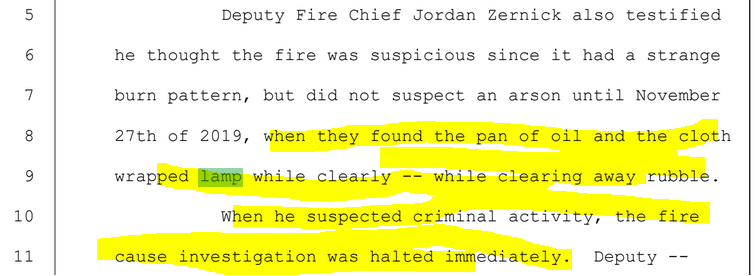


These are brief snippets of testimony and reports; for full details and additional statements regarding the cloth and lamp, please visit our evidence room. It’s evident that investigators and witnesses determined this cloth played a role, associating it with the lamp as part of an incendiary device.
While reviewing a photo of the evidence collected, the homeowner noticed something unusual. It wasn’t just the presence of the cloth, which investigators had already flagged, but rather the amount of cloth wrapped around the lamp and its appearance in a tightly bundled formation. Knowing he had never wrapped anything around the lamp, he found it suspicious how the cloth seemed to be wrapped multiple times around the lamp pole, almost in a ball-like configuration.
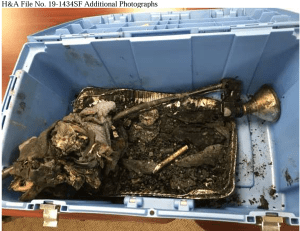
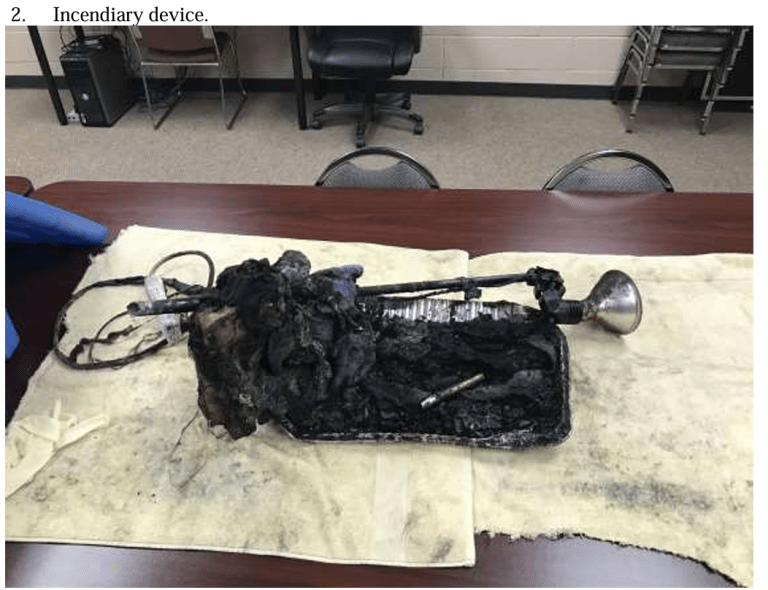
It is important to note that the above two photos were taken by third-party insurance fire investigators on January 20, 2020. Between the date of the fire and January 20, 2020, the evidence had been removed and reviewed multiple times. The way it appears in the evidence bin is not how it was initially found at the scene. The purpose of reviewing the above photos is to observe the amount of material collected rather than to determine its original placement.
On November 27, 2019, the Fire Marshal began his excavation of the closet. Through a FOIA request, the homeowner obtained photos of the scene, noting that these images were suspiciously never provided to him or his lawyer in the discovery file. According to the homeowner, these omissions raised serious concerns. The Fire Marshal’s own photos show how the lamp, tray, and cloth were found in the scene before they were picked up, moved to the homeowner’s pool table, and subsequently flagged for Sergeant Harpe to seize as evidence.
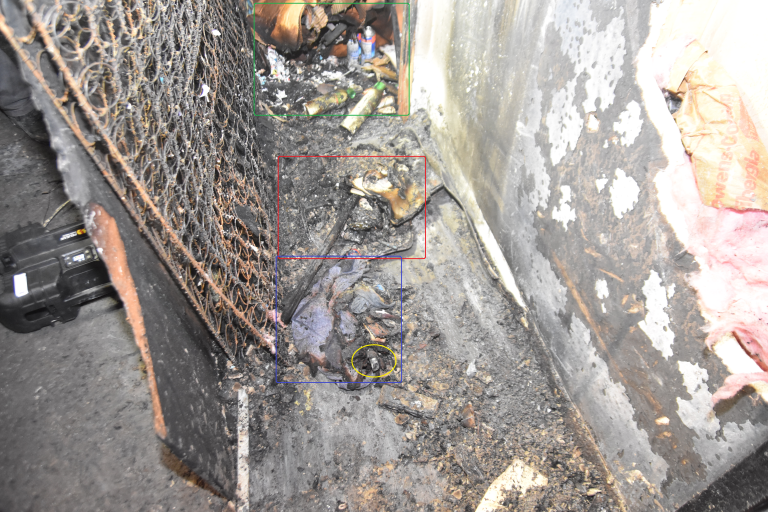
The above picture, taken just before the “device” was moved, indeed shows the lamp pole, cloth, and tray together, with the cloth surrounding the pole, just as the prosecution suggests. The following picture captures the moment when Fire Marshal Jordan Zernick and insurance investigator Jeremy Berard moved the tray to the pool table. Notably, the tray and cloth appear in a similar position to their arrangement in the previous photo.
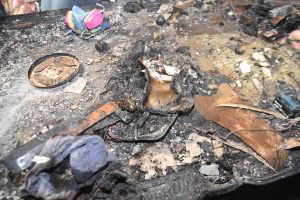
Initially, the homeowner was stunned, considering the possibility that their claims might be truthful. However, as he continued to examine the Fire Marshal’s other photographs, he uncovered what would become the most significant discovery in the entire case.
During excavation, it is essential to document items as they are moved, typically achieved through the process known as “delayering.” In this procedure, investigators photograph each item at its original location before removing it, ensuring a clear, step-by-step record of the excavation. The fire marshal’s photos, taken throughout this process, provide valuable metadata, allowing precise identification of the times specific items were uncovered and moved. This careful documentation is crucial in maintaining an accurate and traceable investigation timeline.
Upon a thorough examination of all the photos, the homeowner discovered two sequential images that seemed inconsistent with each other. These two photos, taken at different stages of the excavation process, show subtle differences in the arrangement of items, suggesting something may have been altered between shots. This discrepancy raised questions for the homeowner, as the images didn’t seem to align with a logical progression in the documented investigation process.
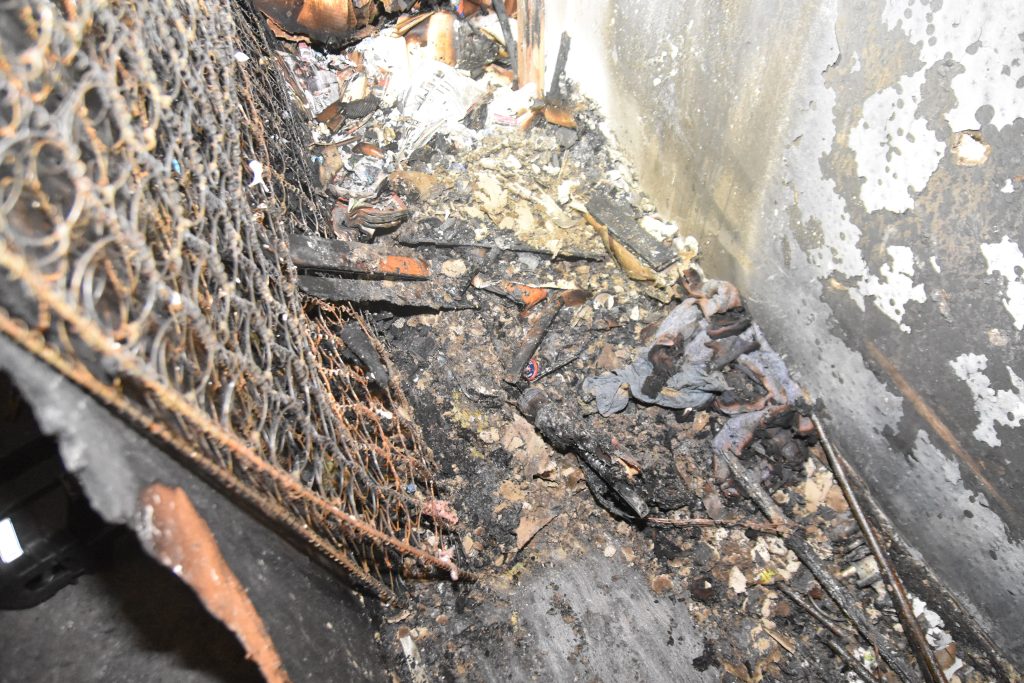
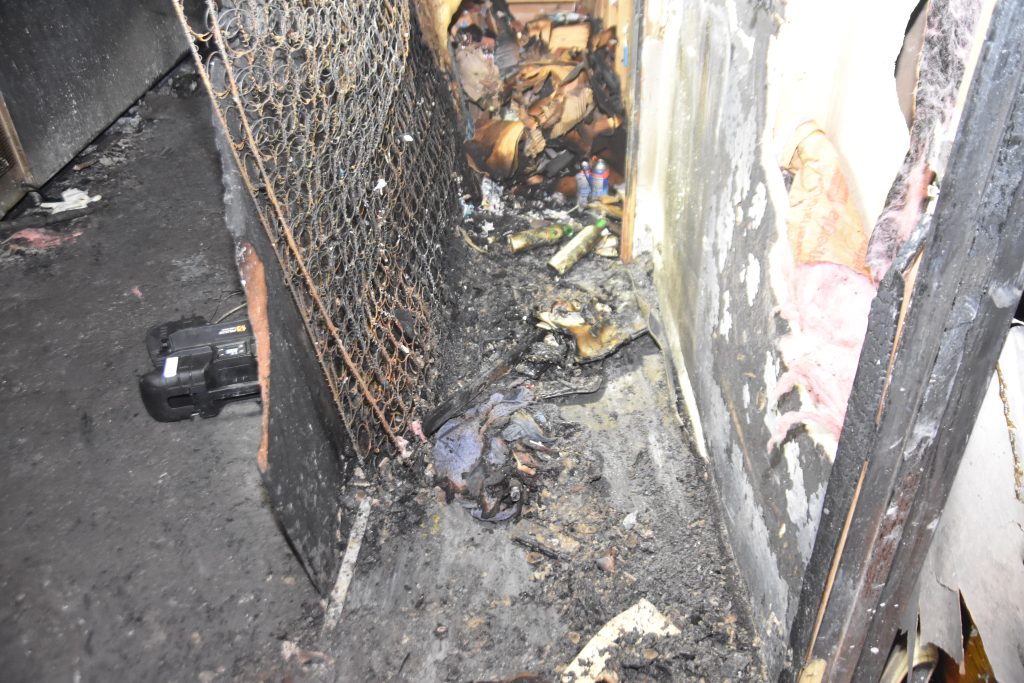
At first glance, the difference might not stand out, but when we zoom in on the “device” and examine the timestamps, the inconsistency becomes apparent. In the image on the left (or 1st picture on mobile phones labelled FM1_0726), the “cloth” is not wrapped around the lamp pole. Yet, four photos later—from Picture FM1_0726.JPG to Picture FM1_0730.JPG—the “cloth” suddenly appears wrapped around the pole.

In the initial photo, there is no cloth wrapped around the lamp; in fact, the “cloth” is positioned against the wall. However, ten minutes and 54 seconds later, the same “cloth” is now wrapped around the pole. The timestamps on these photos suggest that an investigator may have deliberately altered the scene, wrapping the cloth around the lamp to create a misleading impression. Presumably to stage the scene and setup the homeowner.
What started as a suspicion of scene staging by the homeowner is now solidified with clear photographic evidence. These crucial photos were never provided to the defense in discovery. Why might the scene have been staged but the photos withheld? It becomes clear when considering that the setup of the lamp, tray, and cloth was only presented to Sergeant Harpe after it was moved to the pool table. At that moment, Sergeant Harpe—trusting the Fire Marshal—saw the configuration with the cloth wrapped around the lamp, appearing intentional. He then collected the entire assembly as evidence, placing it in the evidence bin.
From that point onward, every investigator who examined the items—whether from the ATF, independent experts like Jay Herrick (an electrical engineer), or Jeremy Berard (a fire investigator)—was assessing staged evidence, unknowingly drawing conclusions based on an altered scene. This manipulation raises profound questions about the integrity of the investigation.
When asked about this discovery, the homeowner responded, “It’s deeply troubling, but honestly, it’s just one more piece in a long chain of misconduct. I’ve suspected something like this for a while, but seeing it now, documented in their own photos, is surreal. They withheld these photos, knowing they were critical, and presented the staged evidence as if it was found that way. This changes everything because it wasn’t just an oversight; it feels like a deliberate attempt to frame me. But this is exactly why I fought so hard to uncover the truth. There is even more here but I can’t release it because we know at the time they moved this tray there was more than just one person present, did they all know about this is the question and I have the answer to that too but it will be saved for in court. I think to myself what else did they do that I didn’t catch them doing? This does bring closure to operation 232 because if I keep looking my mental state will be further in trouble, it’s been a challenging 5 years for everyone.”
Disclaimer: This article includes snippets of testimony, evidence, and information, which are provided for informational purposes only and should not be interpreted as legal advice. Behindthefire.org, its associates, writers, or contributors do not make any claims or assertions regarding the content of this article. All individuals mentioned are presumed innocent until proven guilty in a court of law. Any references to criminal activity are allegations, and no one has been convicted at this time. We encourage you to review our evidence page to see everything in its entirety. Readers are strongly advised to use this information responsibly, conduct their own research, and consult with a qualified attorney for legal guidance specific to their situation.
Behind The Fire - Hamburg, MI is proudly powered by WordPress